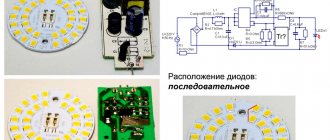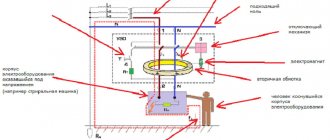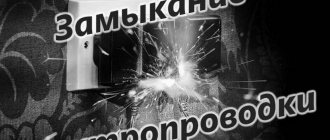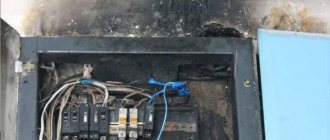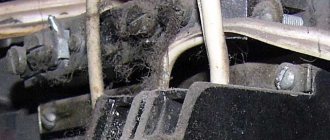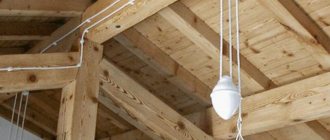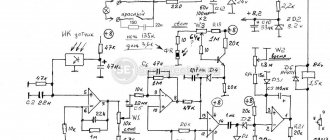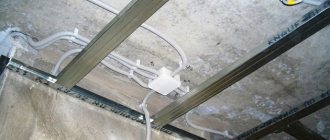METHODS OF STEWING HOW TO STEW
There are several reasons why wiring in an apartment catches fire:
- short circuit;
- increasing the load beyond the permissible limit;
- violation of contacts in electrical installation products and connection points.
The topic is popular and widely discussed on the Internet. Therefore, in this article, obvious questions regarding the reasons for the fire of electrical wiring or an electrical appliance are considered concisely, without “water” and, I hope, to the point.
First, a short review on the topic “how wiring in an apartment lights up.”
Short circuit (short circuit).
First of all, a short circuit in the wiring is a consequence. There are several reasons for its occurrence, but apart from the deliberate connection of two wires, it all comes down to a violation of the insulation.
Theoretically, in this case, a circuit breaker (AB) should protect against fire.
Indeed, it reacts to short-circuit overcurrents almost instantly. That is, along the entire length, the wires most likely will not heat up to the ignition temperature, but a spark (arc discharge) occurs at the point where the short circuit occurs.
This can locally heat materials in the immediate vicinity to ignition temperatures.
More details
Exceeding the permissible current load.
Any wire has resistance and when current flows through it, heat is generated. When the heat sink is insufficient, the wire can heat up to a critical temperature, causing ignition or breakdown of the insulation, followed by a short circuit in the wiring.
A similar situation can arise if the cable cross-section and circuit breaker are incorrectly selected for specific operating conditions. But even with correct calculations, situations often arise when the line in an apartment is overloaded with additional consumers already during operation.
In addition, when calculating electrical wiring, factors that impede heat removal are not always taken into account.
Especially it concerns :
- hidden wiring in wooden houses;
- cable channels;
- pipes
The problem is that in such situations, the circuit breaker may not trip or trip late.
Loss of contact.
Probably the most common reason. Everyone is familiar with sockets, switches and plugs that “spark” in the apartment.
There are several factors that cause fire here: spark, overheating, short circuit.
What to do if there is a wiring fire
Statistics show that people often do not know the rules of conduct when an electrical cable burns. The algorithm of actions in such a situation is as follows:
- De-energize the room. It is advisable to turn off the input machine.
- Put out the fire. If necessary, you can call a neighbor for help.
- When localizing the fire, do not touch surfaces. They're hot.
- The fire extinguishing agents used must not conduct current.
- If you realize that you cannot control the fire, call the fire department.
First actions
The causes of electrical panel fires in the entrances of microdistricts are often unknown. Despite this, the liquidation procedure has the following sequence:
- Do not panic. Do everything quickly, but calmly.
- Unscrew the plugs or turn off the machine.
- Evacuate women and children.
- Call the fire department.
- Eliminate the air supply. Close the windows and doors.
- Wet a towel and cover your nose with it.
- Find the source of the fire. Use available means to eliminate it (blanket, soil from flowerpots).
- If there is a great risk to your life, leave the premises. Wait for the rescuers. They will localize the fire and find out who is to blame.
- After extinguishing the fire, call an insurance representative and demand payment of compensation.
How to stew
Localizing a wiring fire can be done in four ways:
- Turn off the power to the burning network and use available means.
- Use fire extinguishers that correspond to the fire class. This option is more suitable for enterprises.
- Extinguishing non-de-energized wiring can only be done with sand or earth. The use of other improvised means is life-threatening.
- To put out fires in winter, you can use a snowball. A well-aimed hit at the source of fire will short-circuit the wiring and the machine will turn off.
In order to prevent network overload or short circuit, it is necessary to make simple calculations. If the wiring in the electrical panel smells, in order to avoid a fire, you need to take the device and inspect it. There is a video that describes in detail how to do this. If you are not confident in your own abilities, call an electrician.
Why is the electrical wiring on fire?
Protection measures
It is much easier to prevent a wiring fire in an apartment than to try to recover from the consequences of a fire. Therefore, to prevent wiring fires, certain safety precautions should be observed:
- At the stage of installation or replacement of electrical wiring, it is necessary to provide a margin for the cable cross-section. This will allow you to increase power if you connect any new device without the risk of fire.
- Ensure that wires are insulated from flammable materials using non-flammable gaskets. For example, on wooden walls it is important to use a special corrugated pipe, textolite strip, asbestos plates and other non-combustible materials. A metal strip can only be used if it is grounded through an RCD, since in the event of a fire in the wiring, potential will transfer to the metal.
- When replacing wiring, you should use a copper cable specifically designed for domestic premises. Despite its high cost compared to aluminum wiring, it is much more reliable. And modern insulating materials do not support combustion, which makes it impossible for such wiring to catch fire.
- Do not connect wires inside walls. Such components cannot be detected until a fire occurs. Therefore, all conductors from the box to the consumer, switch or socket must be solid. And at the connection points they must be connected with factory clamps, avoiding twists.
- If there is a connection between aluminum and copper conductors in the house, such a point should be fixed using a brass sleeve or a special terminal clamp. Even the use of a brass gasket and tightening with a bolt does not provide a 100% guarantee, since the gasket is destroyed and oxidized over time due to the flow of electric current. Figure 2: Wire Connection
- Do not use shields, cabinets or boxes made of flammable materials. Since in the event of a fire in the same electrical panel, the housing itself will support the combustion. Which will lead to the spread of fire to adjacent elements of the building. If metal distribution panels are used, the fire will not spread beyond its boundaries.
- Use short circuit protection both between cable cores and to ground. It is necessary to select an RCD in such a way that it allows you to de-energize the network in the event of a fault in the wiring or devices, when connecting a load that is too large for wiring, and in other emergency situations. Figure 3: Connecting machines
- Refuse to use faulty devices - if you notice damage to the insulation, unusual noise and other signs, take it for repair. The operation of such devices not only threatens their breakdown, but can also lead to a fire in the wiring.
- When repairing equipment or any elements of the electrical network, turn off the power to the room. Since the cause of a fire is often an artificial short circuit made by a careless repairman during work.
- When leaving home, be sure to turn off the power to each device whose operation is not necessary in your absence. Since the cause of a short circuit and further fire in the wiring can be an unloaded device. And if you are away from the apartment for a long time, it is better to turn off the input machine.
It should be noted that the best way to prevent a fire is a fire alarm. Especially for wooden houses or rooms with flammable finishes. Since it will notify about burning wiring even before the critical spread of the flame. Despite the additional costs, this solution will ensure fire safety for your home.
Conclusion
The causes of electrical fires are associated with faulty condition of electrical wiring, electrical equipment, and its improper operation.
To prevent fire, you should repair electrical wiring, sockets, switches, and use only serviceable devices.
It is prohibited to place the equipment near flammable objects, surfaces, or substances. The premises must have primary fire extinguishing means.
This is interesting: The keys of the pass-through switches are in different positions: let’s understand it thoroughly
Secondary fire extinguishing media
When calculating how much and what primary fire extinguishing agents are needed at an enterprise, the physical and chemical properties are taken into account, as well as the degree of fire hazard and flammability of all substances that are used in production or stored in warehouses.
For optimal placement of materials and extinguishing agents, the area and configuration of the organization’s territory must be taken into account.
Primary fire extinguishing means include:
- Fire extinguishers of various types;
- Fire hydrants;
- Fire-fighting equipment: Barrels with water;
- Boxes with sand;
- Felt or felt;
- Asbestos sheet;
- Buckets;
Tools and inventory
The cheapest and easiest to store material for primary fire extinguishing after water is sand. It is used mainly for extinguishing liquid flammable substances (gasoline, natural and artificial oils, coatings, kerosene, etc.), localizing small fires and preventing their spread.
There are several simple rules for storing sand:
- Boxes with a volume of 0.5 to 3 m3 must have a lid wide enough to provide free access to the contents.
- It is allowed to use shortened metal barrels with lids for storage.
- The container must be installed in a place inaccessible to rain or snow.
- The suitability of sand for use is checked up to twice a year.
When extinguishing liquid substances, sand should not be poured onto the combustion site - the burning liquid will splash. You should sprinkle the outer edge of the combustion zone and only then rake sand onto the liquid.
Fire extinguishing in electrical panels, system selection
Felt, felt, asbestos cloth - are used to extinguish small fires by throwing material onto the source of fire to stop the access of air. It is produced in the form of canvases with an area of at least 1×1 m, while the felt and felt are impregnated with fire retardants.
Rolled materials should be stored rolled up in a metal box, in a room with low humidity, so that the web does not rot.
The use of these materials for extinguishing is not very effective, so they are more often used to protect valuable stationary equipment during extinguishing by other means.
Hooks, axes, and crowbars are used to open rooms or separate burning structural elements. They are placed on fire panels.
Fire shields
The devices are used for fastening and placing fire-fighting equipment and auxiliary tools in premises for various purposes and on the internal territory of the organization. They must be installed in accessible places, the passage to which cannot be blocked.
Actions in case of electrical fire
Electricity is an integral part of every person’s life, which makes life easier and more comfortable. However, if certain rules for using electricity are not followed or working with faulty electrical appliances can lead to property damage or pose a threat to human life and health. For example, many people live in houses that were built several decades ago, and the electrical wiring of the premises remains from those times. Of course, the condition of such electrical wiring leaves much to be desired, and if the wires are not replaced in time, a fire may occur, which in the worst case may develop into a fire.
Water and foam.
All types of devices, including foam ones, are used only on a de-energized system. This is how they extinguish fires that are visible and de-energized devices.
Powder.
A class E fire extinguisher is a powder extinguisher and is designed specifically for extinguishing electrical appliances and wiring. The essence of the powder action is that it knocks down the flame and covers the fire site with a layer, isolating it from oxygen. This type is very effective and has proven itself. It should be extinguished from a distance of at least a meter from the fire.
Classification of fire extinguishers by type of extinguishing agent
Carbon dioxide.
One of the most effective types of fire extinguishers. The principle of operation is that carbon dioxide sharply reduces the temperature and knocks down the flame. Also, after evaporation, it does not leave any traces; it can be used at a voltage of 10,000 VV. You can extinguish from a distance of at least a meter from the fire.
In the event of a fire with live wiring or electrical appliances, a number of requirements must be taken into account:
- It is required to make grounding for all special equipment: foam generators, special vehicles, hoses.
- A safe distance must be maintained.
- Foam devices are prohibited.
- You must be equipped with personal protective equipment.
How to replace old wiring with new one
The main rule when carrying out such work is to do everything according to plan, to perform all actions in strict sequence. Otherwise, you may find that there are not enough or, on the contrary, too many of the necessary materials, the wire is laid in the wrong place, or the cable is connected incorrectly. To properly replace the wiring in an old house, follow a certain system:
- Determine the scope of work and draw up a diagram.
- Calculate how many materials you will need and purchase them.
- Prepare the necessary tools.
- Remove completely or cut off the old wiring.
- Mark the new wiring.
- Mount it.
- Check how everything works.
This will be a general plan of work to replace the old wiring. Now let's go through each point in detail.
Main reasons
All causes of electrical fires are based on two factors - poor electrical contact or its occurrence where it should not exist, that is, a short circuit. The first causes excessive heating at the site of poor contact. The second leads to an instant increase in current, the magnitude of which is proportional to the network resistance. Due to the exclusion of household appliances or other load from the circuit during a short circuit, the resistance becomes negligible, and the current increases to tens and hundreds of amperes.
In practice, the causes of wiring fires are:
- Aging of wire insulation is especially typical for old wiring, where, due to natural processes, the dielectric material has already lost its basic functions (cracked, crumbled), which determines the presence of channels for the flow of current. When the insulation is completely destroyed, channels appear that accumulate dirt, which is a conductor, and cause a short circuit with subsequent fire in the wiring.
- Contact failure can be characterized by both oxidation of the contacting surfaces of conductors and their weakening. In most cases, both factors occur due to excessive heat. With thermal expansion, the metal is deformed each time, which reduces the contact area. Also, heated metal interacts much better with surrounding substances and undergoes ionization.
- Connecting an aluminum cable together with a copper cable - in the case of such installation of electrical wiring, diffusion of charged particles occurs from aluminum to copper wires. Because of this, aluminum deteriorates over time, which significantly worsens contact. This leads to heating and poses a further risk of fire. Figure 1: Copper and Aluminum Connection
- Laying wiring over flammable elements - typical for plastic, wood or paper materials with which the wiring has direct contact. When it is heated, smoldering and subsequent fire of such a structure are possible. This factor is especially dangerous in the case of hidden wiring, when the initial stages of a fire remain hidden inside the wall.
- The cross-section of the wires does not match the connected network load - excessive load leads to overheating of the wires. In this case, the wire breaks due to thermal destruction. In places where the insulation is weakened or in the presence of flammable elements, such overheating will lead to burnout of both the conductor itself and the surrounding structures.
- Malfunction of electrical appliances causes short-circuit currents to flow through the wires. Since some devices provide reinforced insulation, which is much newer and better than that on wires, the wiring burns out much faster and can lead to a fire in the wiring and a further fire.
- Connecting non-standard devices - the lack of any testing before putting them into operation, the use of ineffective insulation or installation on a flammable base makes them potentially dangerous. Because of this, it is strictly prohibited to connect devices of dubious origin in order to avoid their fire or fire of the wiring.
- Failure or non-compliance of protection devices - to prevent any consequences from short circuits, a machine is installed at the entrance to the apartment. If the circuit breaker has a much higher permissible limit than the cable can withstand, then gradual overheating of the wiring occurs with destruction of the insulation and thinning of the wire. Which will ultimately lead to a fire in the wiring.
- Breakage of sockets or plugs - in places where devices are connected to the electrical network, contacts may become loose, the housing may be destroyed, fasteners will loosen, and other damage may occur, leading to excessive heating in these units. Such problems are characterized by sparking when the electrical appliance is turned on, a corresponding cracking sound, or may be felt as excessive temperature when the plug is touched.
It should also be noted that even a slight thermal effect on the insulation leads to its gradual destruction. And when a certain temperature level is reached, the dielectric properties decrease significantly due to the ionization of inclusions in the insulation, leakage current, melting and subsequent fire may occur. What to consider when turning on multiple powerful devices at the same time.
Transition resistances
Transitional
are called
resistances
in places where current passes from one contact surface to another through the areas of their actual contact
.
In such a contact connection, a certain amount of heat is released per unit time, proportional to the square of the current and the resistance of the areas of actual contact.
The amount of heat generated can be so significant that the transition resistances become very hot. Consequently, if heated contacts come into contact with flammable materials, they may ignite, and contact of these places with explosive concentrations of flammable dust, gases and vapors of flammable liquids will cause an explosion.
To increase the areas of actual contact between the contacts, it is necessary to increase their compression forces by using elastic contacts or special steel springs.
To remove heat from points of contact and dissipate it into the environment, contacts with sufficient mass and cooling surface are required.
Thus, to ensure safe working conditions in existing electrical installations
a set of measures should be provided that are implemented at all stages - before the start, during the implementation and at the completion of the work. Activities mean the organization of certain actions in electrical installations (registration of work, appointment of those responsible, preparation of the work site, conducting briefings, etc.), as well as specific manipulations with electrical installation devices (switching, checking the presence or absence of extinguishing in live parts, installation of protective grounding and others). In addition, it is worth taking into account local conditions and applications of electrical installations.
Considered causes of fires
are relevant. Today, a person cannot do without machines, installations and computers. Every year, as practice shows, the use of electrical installations is increasing, and the sooner measures to prevent fires are developed and taken, the safer the future awaits us.
Elimination of short circuit consequences
If the search for the short circuit was successful, then it’s time to exhale and start eliminating it. What to do next depends on the extent of the damage to the electrical wiring. Regardless of the situation, before starting any repair work, you should definitely turn off the power to the apartment and make sure there is no voltage.
It is necessary to assess how much the cable insulation was damaged at the time of the short circuit. If there are swelling, darkening or melting, the wire must be replaced. If possible, it is necessary to assess its condition along its entire length.
Connecting wires in the distribution box using terminal blocks
If the wire covering is in order, then the immediate location of the short circuit is removed. The surviving ends of the current-carrying conductors are stripped and connected using Wago terminal blocks, welding, soldering or crimping. In low-current circuits, you can use regular fast twisting at your own risk. However, the PUE (7th edition, clause 2.1.21) does not provide for and does not approve of this method of connecting cables.
Hazard Prevention Measures
The first and most effective way is to install special protective devices in the shield. For example, an RCD will help prevent current leakage in the apartment in time, a circuit breaker will help prevent short circuits and overvoltage, and a voltage control relay will prevent the occurrence of two phases in the socket, as well as overvoltage. Please note that you can only use an RCD if you have grounding, as required by the PUE in Chapter 1.7, namely in paragraph 1.7.80.
The next thing you need to take care of is to inspect the electrical wiring at least once a year (or better yet, every six months). This will allow timely detection of poor contact, cable damage or overheating of current-carrying conductors. Here you can also include an assessment of the condition of the old wiring. You need to be aware of when it is better to replace the entire home electrical system. Don't forget about the main signs of an electrical problem - crackling noises, sparking sockets, a burning smell. If any of these signs show themselves, you need to immediately start looking for a breakdown.
And lastly, follow safety precautions during repairs. Before hanging the TV on the wall, determine where the hidden wiring is located so that you don’t accidentally get into it when drilling. We talked about how to find a wire in a wall in the corresponding article. In addition, do not forget that you need to connect aluminum to copper only using special terminal blocks, and electrical installations are only allowed during a complete power outage.
So we looked at possible electrical wiring faults in an apartment and a private house. We hope the article was useful and interesting for you!
Tags: machine, beat, sconce, input, input machine, view, harm, choice, switch, house, , clamp, grounding, sign, insulation, cable, like, , installation, power, voltage, overvoltage, potential, touch, wire, project, laying, start, , work, calculation, relay, repair, socket, row, network, twist, connection, resistance, means, ten, type, current, installation, shield, electricity, electrical panel, effect
Fire extinguishers in electrical installations up to and above 1000V
Burning electrical wiring poses a serious danger. To extinguish it, you need to use special fire-fighting agents that guarantee efficiency and safety in extinguishing a fire. It is necessary to clearly know which fire extinguisher can and cannot be used when extinguishing live wiring.
Causes of electrical wiring fires Electrical networks in a home or business are a source of danger to humans. Failure to comply with safety precautions can result in severe electric shock and fire.
Main causes of fire:• Technical malfunction of electrical wiring
The condition of all nodes of the utility network should be taken into account. This is a distribution panel to which the main input cable and branch are connected and protection devices are installed
All devices must function.
It is necessary to provide backup protection in case of failure of one of the devices
Particular attention should be paid to the quality of the conductor contact connections. For reliable and safe operation of electrical wiring (especially in wet rooms), you will need residual current devices
• Dangerous operation of electrical appliances. When connecting any devices, you should take into account the maximum load of the network and the presence of a grounding contact in the outlet.
Protective means in electrical installations
One of the reasons for electrical wiring fires is a large load on one of the outlets, to which several units are connected through splitters and extension cords. In addition, damaged cords and plugs of devices pose a danger.
After connecting the electrical appliance to the network, after some time it is necessary to disconnect it and check the plug for overheating. If the plug is hot, it means that the contact fasteners are damaged.
• Problems when using lighting. Lighting devices often cause electrical fires. In rooms with high humidity, it is necessary to protect lamps from splashes and switches from humidity.
The main requirement for any problems with electrical wiring is to completely turn it off. To prevent a fire, at the first sign of a short circuit, it is necessary to turn off the power to the network, and only then begin repairs.
Only professional electricians wearing a special protective suit can work with a live network; this eliminates the risk of electric shock.
How to extinguish electrical wiring - short circuit, cause of wiring fire
The occurrence of a powerful and destructive current pulse in the network is called a short circuit. It occurs at the moment when the wires of the circuit are connected, but the current does not flow into electrical appliances. The wiring heats up and starts a fire. If sparking or open flame appears, turn off the electricity immediately.
If access to the plugs is impossible, the wires must be cut off with any electrically insulating tool. The first signs of a future short circuit may be interruptions in the operation of lighting and electrical appliances. They should be checked for integrity of wires and contacts.
There is current in the burning live wiring, so if it is not possible to turn off the panel or cut the wires, you must call the fire department.
Extinguishing burning electrical wiringExtinguishing live electrical wiring with water is prohibited. Water is an ideal conductor of current and a person who pours water on the wiring is guaranteed to receive an electric shock. If the network is de-energized, then you can use water, sand or any fire extinguisher at hand.
If it is not possible to turn off the power, you can only use a fire extinguisher that is marked on the body that it can be used for class E fires. This classification corresponds to fires in electrical installations. To extinguish fires in electrical installations, some powder and aerosol extinguishing agents are used.
They are designed for extinguishing wiring and electrical installations under voltage of no more than 1000 volts (optimally about 300 volts). If higher voltage is present, it is necessary to look for ways to de-energize the network. It is impossible to use foam-air and foam-chemical compositions under voltage. In winter, you can try to extinguish burning external electrical wiring with snowballs.
They will cause short circuits and trigger the network’s protective mechanism.
How to extinguish electrical wiring - rules for extinguishing wiring with a fire extinguisher
• Powder-filled fire extinguishers can extinguish burning electrical appliances with voltages up to 1000 volts; • If the length of the carbon dioxide jet is less than three meters, only equipment with a voltage of 1 kilovolt can be extinguished.
Fire protection measures
Various protective measures should be taken to keep the wiring in good condition, for example, laying it under plaster rather than under flammable building materials. As for shields, it is better to choose them from metal or non-flammable plastic - this will serve as protection against the spread of fire. We described in detail how to choose an electrical panel in a separate article.
It is also important to inspect the electrical wiring at least once a year: look at all wire connections in sockets, switches, junction boxes and in the electrical panel itself. Timely detection of poor contact and melted wires is one of the effective ways to protect against fire
If the wiring is old, be sure to replace it with a new one during the next repair. Cracked insulation, old sockets designed for a lower current load, plugs in the panel. All this can lead to a fire at any moment. If it is not yet possible to spend money on replacing the wiring in the apartment, be sure to install automatic circuit breakers and RCDs in the panel. They will save you from a fire at the right time. It is also advisable to install a 100 or 300 mA fire protection RCD at the input in wooden houses as an additional measure of protection.
The fire protection RCD is described in detail in the video:
In addition to all this, it is important to know and under no circumstances repeat typical mistakes when installing electrical wiring, which we wrote about separately. For example, poorly made twisting can cause a short circuit and further fire in the electrical wiring.
Therefore, there is no need to do twists at all.
And of course, if the apartment smells of burnt wiring, and you yourself are not able to find and fix the problem, be sure to call an electrician, having first turned off the circuit breakers in the panel.
Procedure for detecting the first signs of fire
Signs that the wiring is on fire:
- the light begins to blink and goes out over time;
- the room may smell of burnt plastic;
- the appearance of a crackling sound coming from the walls or mounting boxes;
- appearance of white or black smoke;
- darkening of walls where cables are laid.
In the event of an electrical fire, the following measures should be taken:
- Remain calm, convince yourself and others that the situation is under control and its elimination is an easy and safe matter.
- If possible, turn off the power to the apartment - unscrew the plugs, turn off the machine.
- Order that women and children immediately go out to the entrance, begin to notify neighbors in the house and call the fire brigade.
- Close windows and doors to stop oxygen from reaching the flame.
- Wet a towel and wrap it around your face to protect your respiratory system from toxic smoke.
- Bend down or crawl to examine the premises in search of the source of the fire.
- Disconnect all household appliances from the network. After this, throw a blanket, blanket or other thick fabric over the burning device. If there are flowers in flowerpots nearby, you can use the soil in them.
- Proceed to extinguish the fire, using all available methods.
If the situation is not critical, you need to turn off the lights and inspect sockets, switches and wiring boxes. Fires due to wiring most often occur in these places in the presence of poor-quality twists and contacts. A sign of a defect is melted plastic, soot and blackened walls. The cable can also burn out in the groove. This can be determined using a tester. In this case, you will have to change part of the wiring.
What electrical faults can lead to a fire?
September 25, 2017
Usually, after a fire, the first step is to find out who is responsible for such an incident. Accurate information about which electrical wiring faults can lead to a fire will give rise to a claim for damages. Today we will look at what contributes to inflammation and how to protect against its consequences.
Causes of fire
Only strict adherence to safety measures will protect consumers from the threat of fire. Another potential threat in such a situation is electric shock. There are several main causes of inflammation.
technical issues
The connection points and the general condition of the wiring require the closest attention. Constant monitoring is necessary for the installation sites of protection devices and supply lines of cables - distribution and main boards. These network components should be checked for normal operating condition. Also, in case of emergency situations, it is necessary to provide for the installation of backup protection.
Connections are especially dangerous if there is poor contact, which can easily cause a fire. Residual current devices in any room, and especially in areas with high humidity, will guarantee reliability and safety during operation.
Wrong choice of circuit breaker
Instant operation in case of overload or short circuit is the main function of the machine. Therefore, the correspondence of the switch rating to the wiring cross-section remains the main criterion at the stage of selecting the device. If such a requirement is neglected, the operation may not take place or may occur too late.
Errors during operation
Any device has a permissible load limit. Connecting different extension cords or several powerful consumers into one outlet can cause a fire. A potential hazard comes from damaged cords or plugs. At the first signs of heating anywhere in the wiring or device, it is necessary to check the condition of the contact connections.
Problems with the lighting group
Various reasons can negatively affect lighting elements. It is important to take measures to prevent moisture on switches and splashes on incandescent lamps.
Connection of copper and aluminum conductors
Among technical problems, a violation of this kind often occurs. There is a risk of fire even when connecting neutral wires using a special strip. The use of brass as a material for such strips is excluded due to their gradual oxidation. In combination with aluminum, this increases heating processes and the likelihood of fire.
In a situation where such a connection is placed inside a plastic shield, the consequences look even more dire. It is impossible to do without connecting copper and aluminum, but this must be done either using special sleeves or using terminal boxes.
Poor quality sockets
The plug of the device must fit tightly into the socket and be securely fixed in it. If sparks occur or the plug temperature increases, replace the outlet immediately. You should not try to save money and buy cheap models. The plastic in them gets very hot, and the contact connections are made without compression springs.
Outdated wiring
In older buildings, switchboards are located on the staircases. Due to significant neglect, the level of security in such places is practically zero.
The wiring has not been changed for many decades, which means destruction of the insulation and complete unusability of the current conductors.
The likelihood of short circuits increases significantly, which is caused by the use of a much larger number of electrical appliances in apartments and increased load parameters on aluminum wires.
Low-quality electrical goods
On the market, unfortunately, cases of sales of products that are not able to cope with the load specified by the manufacturer have become more frequent. Consumers are faced with the need to replace newly installed cables and wires due to cracks and shedding of insulation.
Main fire protection measures
One of the basic rules is to lay the wiring not under flammable materials, but under a layer of plaster. Shields made of non-flammable plastic and metal have proven themselves in practice.
It is important to consider the need for an annual audit of the electrical network. It is recommended to carefully inspect the electrical panel and distribution box, all switches and contacts in sockets. Identifying defects in joints and areas with signs of melting remains one of the reliable ways to combat fire.
Troubles can happen at any moment due to plugs that are unsuitable for the load, a bad socket or damaged insulation.
Wiring that has served for a certain period of time should be replaced during the first renovation of the premises. Before that, spare no expense on installing RCDs and automatic machines.
In wooden buildings, the installation of a 100 and 300 mA fire safety device at the input is used as additional protection.
Another important point is the absence of twists, which, if performed poorly, become a factor in the occurrence of a short circuit.
If there are signs of burning in the room and you are unsure of your ability to cope with problems, you should turn off the machines and wait for a professional electrician to arrive.
Procedure for detecting the first signs of fire
A clear sign of a wiring fault
Signs that the wiring is on fire:
- the light begins to blink and goes out over time;
- the room may smell of burnt plastic;
- the appearance of a crackling sound coming from the walls or mounting boxes;
- appearance of white or black smoke;
- darkening of walls where cables are laid.
In the event of a fire in the electrical wiring, if possible, it is necessary to de-energize the apartment.
If the electrical wiring catches fire, the following measures should be taken:
- Remain calm, convince yourself and others that the situation is under control and its elimination is an easy and safe matter.
- If possible, turn off the power to the apartment - unscrew the plugs, turn off the machine.
- Order that women and children immediately go out to the entrance, begin to notify neighbors in the house and call the fire brigade.
- Close windows and doors to stop oxygen from reaching the flame.
- Wet a towel and wrap it around your face to protect your respiratory system from toxic smoke.
- Bend down or crawl to examine the premises in search of the source of the fire.
- Disconnect all household appliances from the network. After this, throw a blanket, blanket or other thick fabric over the burning device. If there are flowers in flowerpots nearby, you can use the soil in them.
- Proceed to extinguish the fire, using all available methods.
How to extinguish electrical wiring - rules for extinguishing wiring with a fire extinguisher
Powder-filled fire extinguishers can extinguish burning electrical appliances with voltages up to 1000 volts; If the length of the carbon dioxide jet is less than three meters, only equipment with a voltage of 1 kilovolt can be extinguished.
Types of fire extinguishers and their scope
Water and foam compositions Fire extinguishing devices such as ORP, OV, OHP can be used to extinguish a de-energized network. They can be used to eliminate a visible fire when the cable line supplying burning equipment is broken.
powder compositions A burning electrical panel with voltage up to a thousand volts can be extinguished with a powder fire extinguisher. The powder knocks down the fire and creates a dense layer that blocks the access of oxygen to the fire site. The high efficiency of the “VP” series devices was noted. They can be used at voltages up to 1 kilowatt.
carbon dioxide compounds are considered the most effective in extinguishing fires in electrical installations. The OU series knocks down the flame and reduces the temperature of heated areas. When working with this fire extinguisher, please note that carbon dioxide emits harmful fumes and should not be used in enclosed spaces. At the same time, it has a number of undeniable advantages: It leaves no traces after complete evaporation
This is important for complex electronics. Extinguishes power supplies with voltages up to 10 kilowatts
If you don’t have a fire extinguisher suitable for extinguishing electrical wiring at hand, you can use sand. Safe distance from which to extinguish electrical wiring: For voltages up to 10 kW - at least 1 meter with a carbon dioxide fire extinguisher; For voltages up to 1 kW - at least 1 meter with a powder fire extinguisher;
Basics of the work of the fire brigade when extinguishing live electrical installations: 1. When working with foam compositions, the foam generators, barrels and pumps of fire engines are grounded. 2. maintain safe distances for extinguishing. 3. Foam fire extinguishers are not used. 4. Extinguishing is carried out in specialized clothing.
How to extinguish electrical wiring - conclusions
If it is necessary to eliminate an electrical fire at home, it is necessary to use all possibilities to de-energize the network. Typically, the voltage of the consumer network does not exceed 380 Volts. If de-energizing is impossible for some reason, you should use a powder or carbon dioxide fire extinguisher. It must be remembered that if the insulation is damaged, an electric arc can form, which is dangerous to humans.
You can extinguish live electrical wiring using the following fire extinguishing devices: Up to 400 Volts - powder and carbon dioxide compounds; Up to 1000 V - powder and carbon dioxide; Up to 10,000 Volts - carbon dioxide.
It is prohibited to extinguish live electrical wiring with foam and water compounds, including sea water.
When a fire first flares up, the flame may be so small that it can be easily extinguished with a fire blanket or fire extinguisher. With advance preparation and the ability to quickly identify the type of fire you are dealing with, you will increase not only your chances of successfully extinguishing the fire, but also your chances of completing the entire job safely. However, remember that the safety of others in the immediate vicinity of the fire (including yourself) comes first. If the fire spreads quickly, the fire produces a lot of smoke, or the flame cannot be extinguished with a fire extinguisher in five seconds, you need to sound the fire alarm, evacuate the building and call the fire department by calling 101.
Precautionary measures
If the wiring in a domestic setting catches fire, to eliminate the fire, you must try to cut off the power to the entire electrical network. The maximum voltage in a regular network, including in factories, is 380 V. If it is impossible to de-energize, special means are used - carbon dioxide and powder fire extinguishers. You need to extinguish it carefully, observing safety precautions - there is a risk of an electric arc that can cause harm to a person and he will simply burn.
Extinguishing electrical wiring is allowed with powder and carbon dioxide fire extinguishers. Carbon dioxide ones are suitable for networks up to 10 kW, but powder ones only up to 1 kW. Any of the above is quite suitable for household needs.
It is strictly prohibited to extinguish electrical fires with water or foam. This also applies to all electrical appliances and solutions made from water-based or flammable materials. Highly flammable items should be kept away from fireplaces. This applies to both flammable liquids and things. You should not come close to extinguishing under voltage - there is a risk of electric shock. Therefore, the conclusion is this: how to extinguish electrical wiring depends on the specific situation, but the best option is to prevent fires by systematically checking the systems.
How to prevent an electrical appliance from catching fire?
If there is something wrong with the equipment and there is a risk of a short circuit, then most often we can notice this in advance. We will be told by the specific smell of burning plastic or the strange sounds that an electrical appliance makes.
Sometimes sparks may also be visible. In these cases, you should immediately stop using the equipment, as the risk of fire is very high at this point. Don't neglect this rule. A small spark can lead to irreparable consequences.
Such equipment must either be replaced or taken to a workshop for repair. Once a specific smell occurs, forget that this device can be used at all.
Another rule that must be observed when using electrical appliances is that you should not overload the electrical network. That is, you can’t do it like this:
Electrical short circuit
Regardless of the cause, a short circuit in the electrical wiring is one of the most unpleasant (in terms of diagnosis and repair) malfunctions of any electrical circuit - in an apartment, private house or industrial premises. A particularly difficult case is the short circuit of hidden electrical wiring, because the wires are hidden under a layer of plaster. Even if the home electrician’s tools include devices that will help you find the location of the damage without opening the walls, you will still need to remove the wires to repair it.
Procedure for detecting the first signs of fire
A clear sign of faulty wiring
Signs that the wiring is on fire:
- the light begins to blink and goes out over time;
- the room may smell of burnt plastic;
- the appearance of a crackling sound coming from the walls or mounting boxes;
- appearance of white or black smoke;
- darkening of walls where cables are laid.
In the event of an electrical fire, if possible, it is necessary to de-energize the apartment.
In the event of an electrical fire, the following measures should be taken:
- Remain calm, convince yourself and others that the situation is under control and its elimination is an easy and safe matter.
- If possible, turn off the power to the apartment - unscrew the plugs, turn off the machine.
- Order that women and children immediately go out to the entrance, begin to notify neighbors in the house and call the fire brigade.
- Close windows and doors to stop oxygen from reaching the flame.
- Wet a towel and wrap it around your face to protect your respiratory system from toxic smoke.
- Bend down or crawl to examine the premises in search of the source of the fire.
- Disconnect all household appliances from the network. After this, throw a blanket, blanket or other thick fabric over the burning device. If there are flowers in flowerpots nearby, you can use the soil in them.
- Proceed to extinguish the fire, using all available methods.
The occurrence of an electric arc
When operating electrical equipment, an electric arc may form. This phenomenon has useful properties - it is used in smelting alloys and performing electric welding of metals.
Electric arc structure
If an electric arc appears in power supply devices - domestic or industrial, there is a serious danger of electric shock and fire.
The term “arc flash” is used to indicate the problem. It occurs between two electrodes when the contacts open.
The electrical discharge is transmitted to the environment - air, oil used for transformers, vacuum.
The discharge is described as an explosion, it is accompanied by a loud, sharp sound, the release of heat, and the passage of a large current arc in the barrel.
Correct use of sockets
But of course it’s better to just not let the outlet catch fire. Indeed, in most cases, we practically set the socket on fire with our own hands by mishandling it. Therefore, we will give just a few simple rules that will allow you to avoid getting into such a “hot” situation.
- We will not advise you not to insert foreign things into the outlet, not to water it, and not to do other completely obvious things. Here are the rules that everyone has probably heard about, but for some reason forgotten.
- First of all, remember that each outlet has its own current rating. This parameter is set based on the power of the contact part of the socket. Typically, sockets are made for a current of 6A, which approximately corresponds to devices with a power of 1.3 kW. There are sockets for 10, 16 and 25A, the price of which is naturally slightly higher. More powerful devices can be connected to them. But their power still should not exceed the rated current of the outlet.
In the photo you can see where to look at the rated current of the outlet
- The socket must be firmly fixed in the seat. There should be no play when pulling the fork. Otherwise, each time the socket is used, the wires will be subject to deformation, which will ultimately lead to their breaking and poor contact.
- Do not insert larger diameter plugs into outlets. This leads to deformation of the contact part of the plug and, as a result, poor contact. This in turn leads to heating.
Remember! The higher the resistance of a conductor, the more heat it generates when current flows. At the same time, the higher the temperature of any conductor, the greater its resistance. It turns out that the more the wire is heated, the less current it can normally pass. Therefore, an overheated wire will certainly burn out during further operation.
If the plug or socket shows burnt marks as in the video, be sure to remove the voltage from it and clean it. Otherwise, it will inevitably lead to fire.
Overloads as an emergency mode of operation of electrical equipment
Overload
This is called
an emergency mode
in which currents arise in the conductors of electrical networks, machines and devices that for a long time exceed the values allowed by the standards.
One of the types of transformation of electrical energy is its conversion into heat. Electric current in the conductors of electrical networks, machines and devices releases heat, which is dissipated in the surrounding space. Conductors can reach dangerous temperatures. Thus, for bare copper, aluminum and steel wires of overhead lines, the maximum permissible temperature should not exceed 70°C. This is explained by the fact that with increasing temperature, oxidative processes intensify and oxides with high resistance are formed on the wires (especially in contact connections); The contact resistance increases, and, consequently, the heat generated in it. As the connection temperature increases, oxidation increases, and this can lead to complete destruction of the wire contact.
The cause of
overload may be caused by incorrect calculation of conductors during design. If the cross-section of the conductors is underestimated, then when all the provided electrical receivers are turned on, an overload occurs. Overload may occur due to the additional inclusion of electrical receivers for which the network conductors are not designed.
To avoid overload or its consequences, during design it is necessary to correctly select the cross-sections of network conductors according to the permissible current, as well as electric motors and control devices.
During the operation of electrical networks, you cannot turn on additional electrical receivers if the network is not designed for this.
Maximum load and average energy consumption level
At the moment, not everyone can afford to install a substation powered by solar energy in their country house. However, when planning their installation, you first need to find out what peak load you should expect when turning on household appliances, as well as what average amount of electricity they consume per day.
The maximum load level is determined based on the maximum power of all electrical appliances in the house, so that when several of them are turned on simultaneously, the system in the house can cope with the load.
To determine the average daily consumption of each device, you should multiply its power by the operating time from the network per day. And we find the total energy consumption by summing the energy from all appliances in the house.
Determining general energy consumption indicators will allow you to plan the effective consumption of solar energy generated by solar panels. In addition, the obtained figures make it possible to calculate the power of solar panels for a home in order to know which battery you will need to buy. The capacity of the battery directly affects its cost.
conclusions
In order to avoid fires in the wiring, you must adhere to certain standards:
Do not allow wires to “mix” into one whole. When merging, the temperature will increase. This is natural physics. In addition, the insulating rubber may melt, which is not very good;
- Watch the circuit breaker. It is the main protector against most fires. A malfunction will lead to emergency consequences;
- Place wiring away from moisture. An elementary and simple safety rule, non-compliance with which will lead to oxidation and short circuit;
- Do not mix wires of different metals. Some substances are not friendly with each other and can heat up upon contact. It is best to use adapters;
- Overload. There should not be many devices connected to the electricity network.
This article describes the main causes of electrical wiring failure. There are many more of them. Therefore, you need to be able to predict possible events in order to avoid troubles.

